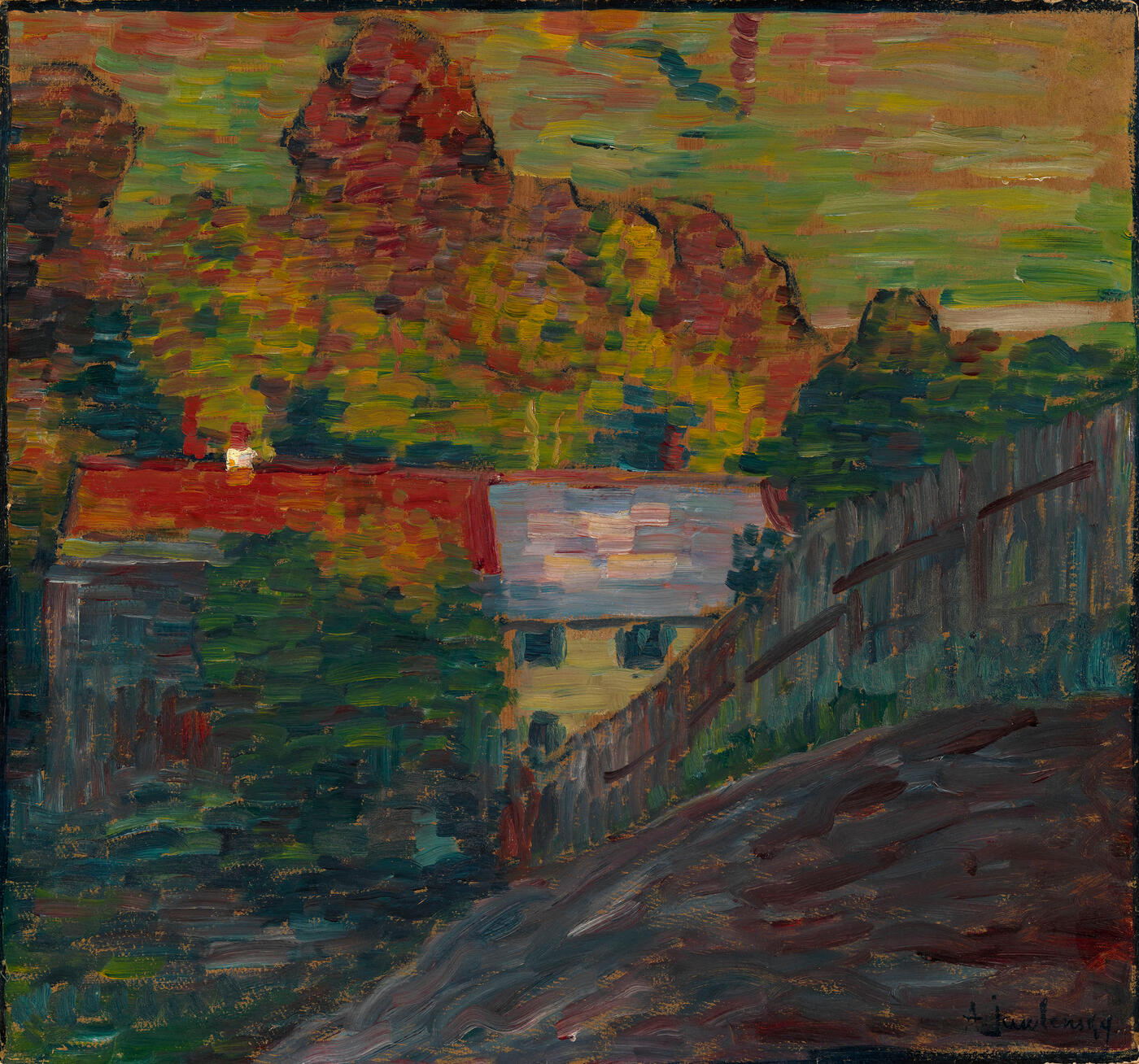MacDougall's Russian Art Auctions 1 December 2011
1 December 2011

51. JAWLENSKY, ALEXEJ VON (1864-1941)
Landschaft mit rotem Dach, Wasserburg, signed.
Oil on board, 48.5 by 52.5 cm.
250,000-300,000 GBP
Executed c. 1906.
Provenance: Museum Wiesbaden, Wiesbaden, acquired by 1952.
Galerie Wilhelm Grosshennig, Düsseldorf, acquired by 1961.
Anonymous Sale; Lempertz, Cologne, 28th November 2007, Lot 154.
Acquired from the above.
Private collection, Germany.
Private collection.
Exhibited: Alexej Jawlensky, Neues Museum, Wiesbaden, 4 September-3 October 1954, No. 10 (label on the reverse).
Kunstwerke aus Galeriebesitz, Städtisches Museum, Wiesbaden, 14 October-117 March 1956-1957, No. 24.
Alexej Jawlensky, Galerie Wilhelm Grosshennig, Düsseldorf, 3-31 October 1961.
Vom Abbild zum Urbild, Ganserhaus, Wasserburg, 5 September-28 October 1979, No. 8.
Literature: C.Weiler, Alexej Jawlensky, Cologne, 1959, p. 262, No. 514, illustrated.
Vom Abbild zum Urbild, Wasserburg, Ganserhaus, 1979, p. 32, No. 8, illustrated.
M. Jawlensky, L. Pieroni-Jawlensky & A. Jawlensky, Alexej von Jawlensky, Catalogue Raisonné of the Oil Paintings, 1890-1914, London, 1991, vol. I, p. 136, No. 145, illustrated.
Landschaft mit rotem Dach, Wasserburg (Landscape with a Red Roof, Wasserburg) is an early work by the outstanding innovator and gifted colourist Aleksej von Jawlensky. It was painted in 1906 at Wasserburg am Inn, at a time when the artist’s enthusiasms for various styles were constantly shifting and he was seeking his signature colour palette.
In January of that year Jawlensky showed nine pictures at the World of Art exhibition in St Petersburg, along with Mstislav Dobuzhinsky, Vladimir Serov and Konstantin Somov. The exhibition was organised by Sergei Diaghilev, who invited Jawlensky and Marianne von Werefkin to spend the winter with him in St Petersburg. That summer the artists set out for Wasserburg, an old Bavarian town with narrow lanes and picturesque views. Jawlensky worked tirelessly, painting from nature, excited by the idea of “life in colour”.
The countryside had a calming effect on Jawlensky: his colours were already less outrageously dazzling, and light and dark bluegreen tones now predominated in his pictures, while his yellows and reds became somewhat muted. The landscape is charged with exceptional energy, conveying the psychological state of a person as he contemplates nature. Jawlensky was a real observer, convinced that it was necessary to devote one’s whole being to take in and commit to canvas the beauty of nature. Of the works of this period — mostly spent in Germany with only occasional visits to Russia — a significant number were landscapes, executed in the spirit of Impressionism. However, over time, the artist adopted the portrait as his favourite genre and this is the genre in which he was to work most and which was clearly the answer to all his creative urges.
Jawlensky was forever trying to find himself and continually discovering new enthusiasms. His acquaintance with Matisse and his passion for the work of Cézanne and later Gauguin, greatly influenced his aesthetic views and it was under the influence of the French masters that Jawlensky developed his individual colour palette, which would blaze particularly brightly on the eve of the First World War.
Notes on symbols:
* Indicates 5% Import Duty Charge applies.
Ω Indicates 20% Import Duty Charge applies.
§ Indicates Artist's Resale Right applies.
† Indicates Standard VAT scheme applies, and the rate of 20% VAT will be charged on both hammer price and premium.